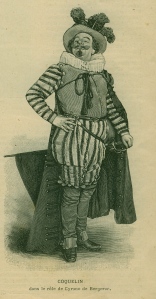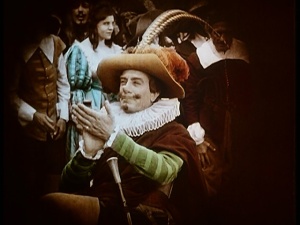Sound AND color in 1900? You’d better believe it! This French short showcases cutting edge technology of its day and is also the only know screen appearance of Benoît-Constant Coquelin (known as Coquelin aîné), the man who created the role of Cyrano de Bergerac on the stage.
Cyrano in Wax
One of the more eye-rolling aspects of movies about the talkie transition is how they treat the evolution of sound films. It’s usually presented like a sudden epiphany that came one fine mid-summer morning in 1927. “I’ve got it! Sound movies! Why, it’s so crazy it just might work!”

In fact, sound films had been experimented with since the very beginning. Considerable blood, sweat and brain cells were expended over the decades to make sound films a reality. Edison’s early films shot in the Black Maria included a brief clip of a violinist playing music for two dancing men. The Edison Kinetophone combined brief movie clips with a wax cylinder phonograph soundtrack.

The French were also hard at work trying to crack the secret of sound film. Their experiments are rarely spoken of these days outside of France but they represent important chapters in the history of cinema. One of these early experiments yielded Cyrano de Bergerac, which is reckoned to be the first color sound film. In 1900. That’s pretty amazing, right?

The color in the film was applied by hand, a fairly common practice at the time, which yields a watercolor-like effect. Any flaws in the application add to the artisanal charm of the production. Just color would have been enough but the picture is also interesting for its casting and, of course, its sound.

First, the cast. Edmond Rostand’s 1897 play based on the life of Cyrano de Bergerac had been a smash hit worldwide and the star, the man who created the role of Cyrano on the stage was Coquelin aîné. And the star of this very first screen version of Cyrano de Bergerac? Coquelin aîné! And in his one and only screen appearance.

This film only runs a few minutes and includes only one scene from the play, the famous duel. As was typical for the era, director Clément Maurice opts to shoot at a polite distance from the actors, assuring that we get the see them from head to toe. In fact, this basically is shot from the point of view of a theatergoer with a particularly good seat.

(If you are unfamiliar with the story of Cyrano de Bergerac, here is the one sentence version: He’s a swaggering swordsman and poet with a cartoonishly large nose, which makes him unwilling to woo his beautiful and intellectual cousin, Roxane, so he offers to help the handsome but dim Christian romance her via letter. And thus the plot to 57% of all romantic comedies was born. But do read/see the original as it’s far deeper than its Hollywoodized remakes and ripoffs would have you believe.)

I’m afraid the sound is almost a total loss (details on that in a bit) as the wax cylinders prove incapable of capturing nuances of delivery. The fact that sound exists is impressive, yes, but Cyrano fans hoping to enjoy Coquelin aîné’s voice will probably be a little disappointed. The body language, on the other hand, is something to behold. Our hero swaggers his way through the duel before casually dispatching his opponent. The character of Cyrano de Bergerac is about dash, panache and mind games and all of that is conveyed in the performance. The beautiful hand-color is the icing on the cake. While the early sound technology has issues, it really is the next best thing to being there.

Now for the main topic at hand: the sound technology of 1900 and whether or not it proved to be a success.
(I am highly indebted to the documentary, Learning to Talk, for the technical and historical portion of this review. It is available on DVD as part of the excellent Discovering Cinema set from Flicker Alley.)

The 1900 Exposition Universelle in Paris was movie mad and there were two dueling sound technologies on display. (Other exhibits included Campbell’s canned soup and the diesel engine, demoed by Herr Diesel himself.) Phonorama used primitive microphone technology and the audience could hear the films thanks to two telephone earpieces in the back of each seat.

The rival Phono-Cinema-Theatre stole the Phonorama’s thunder with celebrities, including Coquelin aîné, Sarah Bernhardt (whose film was actually silent) and other luminaries of the French stage. It used the more established phonograph technology. Sound was recorded on wax cylinders which were then played in sync with the film (a similar concept was eventually used by Warner Bros.’s successful Vitaphone technology).

The great challenge of sound films in those early days was the recording mechanism. In order to be close enough to capture the voices of the performers, the phonograph would have to be visible in the film itself. Since this would hardly be suitable in Cyrano de Bergerac, the Phono-Cinema-Theatre crew opted instead to pre-record the performers’ voices on wax cylinders through the phonograph horn and then have them lip-sync for the camera.
There is an erroneous belief that Phono-Cinema-Theatre was a smashing success but financial records tell a different story. The technology had buzz but that did not translate into ticket sales and the company quietly folded. However, this lack of success did not mean that all sound experiments ended. During the decade and a half leading up to the First World War, moviemakers and engineers continued to wrestle with sound films.

The failure of this method is not surprising as the quality of the sound is… well, it sounds like something you would hear over a rather poor telephone connection. The voices are high pitched and have a honking quality to them. While it’s a marvelous gimmick to hear stars of the turn of the century stage, I think we can all be grateful that these are short films and not features. Heck, I think we’d have trouble sitting through a one-reeler. In any case, the difficulty of syncing sound to image made longer films impractical.

By the way, if you would like to see the full Cyrano as a silent film, I highly recommend the 1925 French-Italian production. Every frame is stencil colored with the famous Mme. Thullier (who colored the films of Georges Méliès) overseeing the process. It is surely one of the most gorgeous pictures ever to grace the screen. (Read my review here.)
While the sound process it uses did not catch on, the 1900 Cyrano de Bergerac is still a valuable piece of film history and represented cutting edge technology of its day. It’s astonishing to see color and sound (granted, applied color and sound on wax cylinder) a quarter century before the talkie revolution in Hollywood.
Movies Silently’s Score: ★★★
Where can I see it?
Cyrano de Bergerac is available on DVD as part of the Saved from the Flames three-disc set released by Flicker Alley. A good deal of work went into the restoration of this rare film and the result is worth it. The entire set is a fascinating tour of firsts, milestones and curios.

Hi Fritzi. That was a nice explanation of early sound efforts. I keep saying we are very lucky to live now when so many things like “Cyrano” are available.
Yes indeed! So many myths and misconceptions about early film history exist simply because it was so difficult to see this stuff for so long.